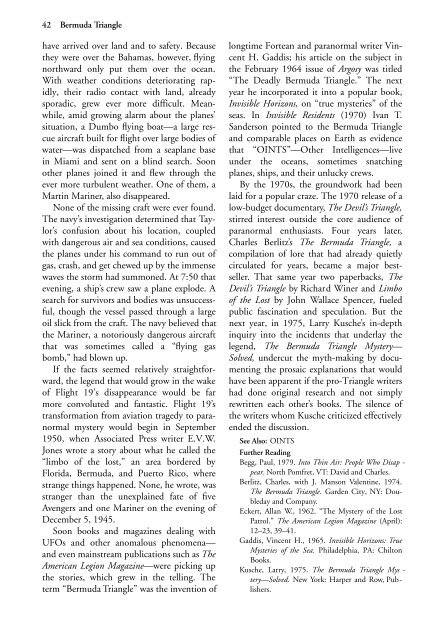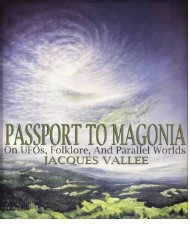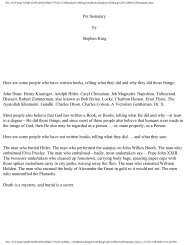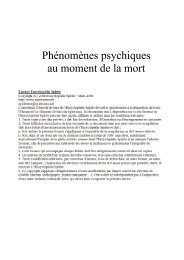extraordinary%20encounters
extraordinary%20encounters
extraordinary%20encounters
Create successful ePaper yourself
Turn your PDF publications into a flip-book with our unique Google optimized e-Paper software.
42 Bermuda Triangle<br />
have arrived over land and to safety. Because<br />
they were over the Bahamas, however, flying<br />
northward only put them over the ocean.<br />
With weather conditions deteriorating rapidly,<br />
their radio contact with land, already<br />
sporadic, grew ever more difficult. Meanwhile,<br />
amid growing alarm about the planes’<br />
situation, a Dumbo flying boat—a large rescue<br />
aircraft built for flight over large bodies of<br />
water—was dispatched from a seaplane base<br />
in Miami and sent on a blind search. Soon<br />
other planes joined it and flew through the<br />
ever more turbulent weather. One of them, a<br />
Martin Mariner, also disappeared.<br />
None of the missing craft were ever found.<br />
The navy’s investigation determined that Taylor’s<br />
confusion about his location, coupled<br />
with dangerous air and sea conditions, caused<br />
the planes under his command to run out of<br />
gas, crash, and get chewed up by the immense<br />
waves the storm had summoned. At 7:50 that<br />
evening, a ship’s crew saw a plane explode. A<br />
search for survivors and bodies was unsuccessful,<br />
though the vessel passed through a large<br />
oil slick from the craft. The navy believed that<br />
the Mariner, a notoriously dangerous aircraft<br />
that was sometimes called a “flying gas<br />
bomb,” had blown up.<br />
If the facts seemed relatively straightforward,<br />
the legend that would grow in the wake<br />
of Flight 19’s disappearance would be far<br />
more convoluted and fantastic. Flight 19’s<br />
transformation from aviation tragedy to paranormal<br />
mystery would begin in September<br />
1950, when Associated Press writer E.V.W.<br />
Jones wrote a story about what he called the<br />
“limbo of the lost,” an area bordered by<br />
Florida, Bermuda, and Puerto Rico, where<br />
strange things happened. None, he wrote, was<br />
stranger than the unexplained fate of five<br />
Avengers and one Mariner on the evening of<br />
December 5, 1945.<br />
Soon books and magazines dealing with<br />
UFOs and other anomalous phenomena—<br />
and even mainstream publications such as The<br />
American Legion Magazine—were picking up<br />
the stories, which grew in the telling. The<br />
term “Bermuda Triangle” was the invention of<br />
longtime Fortean and paranormal writer Vincent<br />
H. Gaddis; his article on the subject in<br />
the February 1964 issue of Argosy was titled<br />
“The Deadly Bermuda Triangle.” The next<br />
year he incorporated it into a popular book,<br />
Invisible Horizons, on “true mysteries” of the<br />
seas. In Invisible Residents (1970) Ivan T.<br />
Sanderson pointed to the Bermuda Triangle<br />
and comparable places on Earth as evidence<br />
that “OINTS”—Other Intelligences—live<br />
under the oceans, sometimes snatching<br />
planes, ships, and their unlucky crews.<br />
By the 1970s, the groundwork had been<br />
laid for a popular craze. The 1970 release of a<br />
low-budget documentary, The Devil’s Triangle,<br />
stirred interest outside the core audience of<br />
paranormal enthusiasts. Four years later,<br />
Charles Berlitz’s The Bermuda Triangle, a<br />
compilation of lore that had already quietly<br />
circulated for years, became a major bestseller.<br />
That same year two paperbacks, The<br />
Devil’s Triangle by Richard Winer and Limbo<br />
of the Lost by John Wallace Spencer, fueled<br />
public fascination and speculation. But the<br />
next year, in 1975, Larry Kusche’s in-depth<br />
inquiry into the incidents that underlay the<br />
legend, The Bermuda Triangle Mystery—<br />
Solved, undercut the myth-making by documenting<br />
the prosaic explanations that would<br />
have been apparent if the pro-Triangle writers<br />
had done original research and not simply<br />
rewritten each other’s books. The silence of<br />
the writers whom Kusche criticized effectively<br />
ended the discussion.<br />
See Also: OINTS<br />
Further Reading<br />
Begg, Paul, 1979. Into Thin Air: People Who Disap -<br />
pear. North Pomfret, VT: David and Charles.<br />
Berlitz, Charles, with J. Manson Valentine, 1974.<br />
The Bermuda Triangle. Garden City, NY: Doubleday<br />
and Company.<br />
Eckert, Allan W., 1962. “The Mystery of the Lost<br />
Patrol.” The American Legion Magazine (April):<br />
12–23, 39–41.<br />
Gaddis, Vincent H., 1965. Invisible Horizons: True<br />
Mysteries of the Sea. Philadelphia, PA: Chilton<br />
Books.<br />
Kusche, Larry, 1975. The Bermuda Triangle Mys -<br />
tery—Solved. New York: Harper and Row, Publishers.





